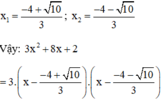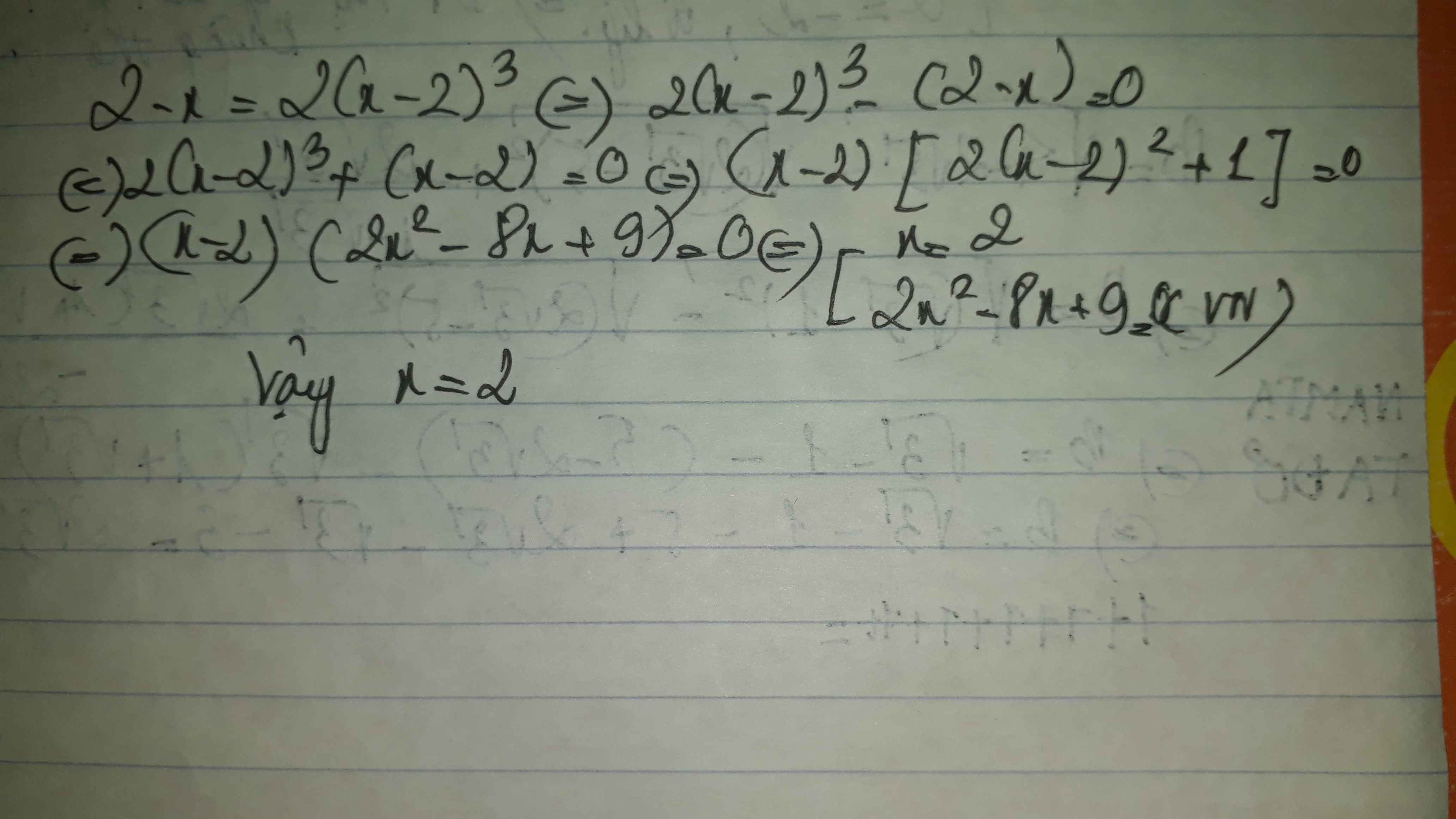Bài này áp dụng kiến thức phân tích đa thức thành nhân tử có áp dụng hđt nha mn
giải phương trình sau: (x-2)^3+(5-2x)^3=0
Mong mn ko lm tắt
Hãy nhập câu hỏi của bạn vào đây, nếu là tài khoản VIP, bạn sẽ được ưu tiên trả lời.

Bn ơi bn có thể giải thích câu đầu tiên đoạn sau giấu <=> đc ko?

\(\left(x^2+2x\right)^2-2x^2-4x-3=0\Leftrightarrow x^4+4x^3+4x^2-2x^2-4x-3=0\Leftrightarrow x^4+4x^3+2x^2-4x-3=0\Leftrightarrow\left(x-1\right)\left(x+1\right)^2\left(x-3\right)=0\Leftrightarrow\left[{}\begin{matrix}x-1=0\\x+1=0\\x-3=0\end{matrix}\right.\Leftrightarrow\left[{}\begin{matrix}x=1\\x=-1\\x=3\end{matrix}\right.\)
Ta có: \(\left(x^2+2x\right)^2-2x^2-4x-3=0\)
\(\Leftrightarrow\left(x^2+2x\right)^2-2\left(x^2+2x\right)-3=0\)
\(\Leftrightarrow\left(x^2+2x-3\right)\left(x^2+2x+1\right)=0\)
\(\Leftrightarrow\left(x+1\right)^2\cdot\left(x+3\right)\left(x-1\right)=0\)
\(\Leftrightarrow\left[{}\begin{matrix}x=-1\\x=-3\\x=1\end{matrix}\right.\)

e) Ta có: \(x^3-4x-14x\left(x-2\right)=0\)
\(\Leftrightarrow x\left(x-2\right)\left(x+2\right)-14x\left(x-2\right)=0\)
\(\Leftrightarrow x\left(x-2\right)\left(x+2-14\right)=0\)
\(\Leftrightarrow\left[{}\begin{matrix}x=0\\x=2\\x=12\end{matrix}\right.\)
e)x3-4x+14x(x-2)=0
⇔ x(x2-4)+14x(x-2)=0
⇔ x(x-2)(x+2)+14x(x-2)=0
⇔ (x-2)(x2+2x+14x)=0
⇔ x(x-2)(x+16)=0
\(\Leftrightarrow\left\{{}\begin{matrix}x=0\\x-2=0\\x+16=0\end{matrix}\right.\Leftrightarrow\left\{{}\begin{matrix}x=0\\x=2\\x=-16\end{matrix}\right.\)
g)x2(x+1)-x(x+1)+x(x-1)=0
⇔ (x+1)(x2-x)+x(x-1)=0
⇔ x(x+1)(x-1)+x(x-1)=0
⇔ x(x-1)(x+2)=0
\(\Leftrightarrow\left\{{}\begin{matrix}x=0\\x-1=0\\x+2=0\end{matrix}\right.\Leftrightarrow\left\{{}\begin{matrix}x=0\\x=1\\x=-2\end{matrix}\right.\)

Ta có: \(2x^3+3x^2+2x+3=0\)
\(\Leftrightarrow x^2\left(2x+3\right)+\left(2x+3\right)=0\)
\(\Leftrightarrow2x+3=0\)
hay \(x=-\dfrac{3}{2}\)

\(M=\left(\dfrac{1}{3}t\right)^2-4\left(t-v\right)^2+2tv+9v^2\)
\(=\left(\dfrac{1}{3}\cdot6\right)^2-4\cdot\left(6+1\right)^2+2\cdot6\cdot\left(-1\right)+9\)
\(=4-28-12+9\)
=-27
\(N=8\left(x-3\right)\left(2x+3\right)+\left(2x-6\right)^2+4\left(2x+3\right)^2\)
\(=8\left(2x^2+3x-6x-9\right)+4x^2-24x+36+4\left(4x^2+12x+9\right)\)
\(=8\left(2x^2-3x-9\right)+4x^2-24x+36+16x^2+48x+36\)
\(=16x^2-24x-9+20x^2+24x+72\)
\(=36x^2\)
\(=36\cdot\dfrac{9}{4}=81\)
a. \(M=\left(\dfrac{t}{3}\right)^2+2tv+9v^2-4\left(t-v\right)^2\)
\(=\left(\dfrac{t}{3}+3v\right)^2-4\left(t-v\right)^2\)
\(=\left(\dfrac{t}{3}+3v-2t+2v\right)\left(\dfrac{t}{3}+3v+2t-2v\right)\)
\(=\left(\dfrac{t}{3}+5v-2t\right)\left(\dfrac{t}{3}+v+2t\right)\)
Thay \(t=6\) và \(v=-1\) vào \(M\), ta được
\(M=\left(2-5-12\right)\left(2-1+12\right)=-15.13=-195\)

a: \(M=m^2\left(m+n\right)-n^2m-n^3\)
\(=m^2\left(m+n\right)-n^2\left(m+n\right)\)
\(=\left(m+n\right)^2\left(m-n\right)\)
\(=\left(-2017+2017\right)^2\cdot\left(-2017-2017\right)\)
=0
b: \(N=n^3-3n^2-n\left(3-n\right)\)
\(=n^2\left(n-3\right)+n\left(n-3\right)\)
\(=n\left(n-3\right)\left(n+1\right)\)
\(=13\cdot10\cdot14=1820\)

a: Ta có: \(2-x=2\left(x-2\right)^3\)
\(\Leftrightarrow2\left(x-2\right)^3+x-2=0\)
\(\Leftrightarrow\left(x-2\right)\left[2\left(x-2\right)^2+1\right]=0\)
\(\Leftrightarrow x-2=0\)
hay x=2
c: Ta có: \(\left(x-1.5\right)^6+2\left(1.5-x\right)^3=0\)
\(\Leftrightarrow\left(x-1.5\right)^6-2\left(x-1.5\right)^3=0\)
\(\Leftrightarrow\left(x-1.5\right)^3\cdot\left[\left(x-1.5\right)^3-2\right]=0\)
\(\Leftrightarrow\left[{}\begin{matrix}x=1.5\\x=\sqrt[3]{2}+1.5\end{matrix}\right.\)

* Chứng minh:
Phương trình ax2 + bx + c = 0 có hai nghiệm x1; x2
⇒ Theo định lý Vi-et: 
Khi đó : a.(x – x1).(x – x2)
= a.(x2 – x1.x – x2.x + x1.x2)
= a.x2 – a.x.(x1 + x2) + a.x1.x2
= 
= a.x2 + bx + c (đpcm).
* Áp dụng:
a) 2x2 – 5x + 3 = 0
Có a = 2; b = -5; c = 3
⇒ a + b + c = 2 – 5 + 3 = 0
⇒ Phương trình có hai nghiệm 
Vậy: 

* Chứng minh:
Phương trình a x 2 + b x + c = 0 có hai nghiệm x 1 ; x 2
⇒ Theo định lý Vi-et: 
Khi đó : a.(x – x1).(x – x2)
= a.(x2 – x1.x – x2.x + x1.x2)
= a.x2 – a.x.(x1 + x2) + a.x1.x2
= 
= a . x 2 + b x + c ( đ p c m ) .
* Áp dụng:
a) 2 x 2 – 5 x + 3 = 0
Có a = 2; b = -5; c = 3
⇒ a + b + c = 2 – 5 + 3 = 0
⇒ Phương trình có hai nghiệm 
Vậy: 
b) 3 x 2 + 8 x + 2 = 0
Có a = 3; b' = 4; c = 2
⇒ Δ ’ = 4 2 – 2 . 3 = 10 > 0
⇒ Phương trình có hai nghiệm phân biệt:




Ta có: \(\left(x-2\right)^3+\left(5-2x\right)^3=0\)
\(\Leftrightarrow\left(x-2+5-2x\right)\left[\left(x-2\right)^2-\left(x-2\right)\left(5-2x\right)+\left(5-2x\right)^2\right]=0\)
\(\Leftrightarrow3-x=0\)
hay x=3